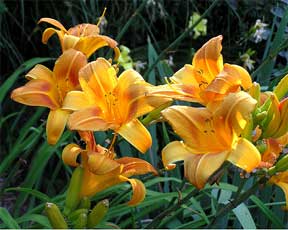It was quite a while, even months in some cases, before the full extent of damage by the March freeze could he fully determined. Some species of plants were only lightly damaged; others died lingering deaths; and still others were killed outright. From it all we should be able to draw some interesting and valuable conclusions relative to the value of winter protection, hardiness, and the importance of proper selection of species for thc various geographical areas.
One point proved was that just a little protection will go a long way. Daylilies in bud and bloom with only light burlap thrown over them were damaged hardly at all, while those left uncovered were killed back almost to the ground. Amaryllis, with a light covering of pine straw, showed little damage while those without any protection were badly frozen. It was the same with the roses and other things.

Of the gardenias, Gardenia erecia. G. radical’c and the variety MYSTERY, were killed back within several inches of the ground, hut the old cape jasmine (Gardenia florida), which perfumed Grandma’s garden, was only slightly damaged.
Along the Gulf Coast and through Florida, gardeners do not have to worry much about winter protection of plants, but through the mid-South it becomes quite a problem. Perhaps the greatest thing we of the Central South learned from the March freeze was the importance of selecting proper species and varieties with respect to winter hardiness. It is important that the major portion of our plantings be made of material that is not only winter hardy as to the plants themselves, but that will delay the development of leaf and flower buds until all danger of freezes are past – plants that can come through our winters unharmed and give a good crop of bloom despite our freakish seasons.
While the new growth of Indica azaleas in this area was killed, most plants do not appear to have been badly damaged and are coming hack nicely. The Kurumes which had developed little leaf growth were only slightly injured. Late-flowering azaleas.
like some of the native types and Kaempferi hybrids, came through in good shape and gave a fine crop of blooms after the freeze.
Probably because they are not quite as showy as the Indicas, the Kaempferis have never been widely planted in the South, but those grown in our town certainly came through with high honors. Two weeks after the freeze they were in full bloom without any indications of having suffered any injury whatever.
The Macrantha azaleas are also late bloomers, but have never been entirely satisfactory with me, due to their tendency to bloom too sparingly over a long season, with never enough bloom at any one time to make a creditable display. In some sections of the South, I am told. they are very good.
More Blueberry Pies!
When it comes to food there are few things that appeal to my appetite with greater force than old-fashioned blueberry pies. For that reason l was greatly interested in a recent release relative to work being done by the Department of Agriculture in developing new varieties of this fruit that will give much greater yields with a highly delicious flavor. I was surprised to learn that there are now approximately 10.000 acres in cultivated blueberries in this country and that the returns approximate S4.000,000 annually. Somehow 1 have a feeling that I have not been getting my share of the pies. Many new varieties have been introduced during the last five years, and among those best for the South are ANGOLA, WOLCOTT, GROTAN and MURPHY.
Plant Day-lilies Now
August and September are the best Months for planting day-lilies throughout the South. The plants become somewhat dormant after flowering and may be moved without any great shock. Most varieties planted now will double in size by spring and give good bloom the first season.
Such perennials and bulbs as ajuga, cerastium. poppies, irises, peonies, daffodils and the spring-flowering lilies may be divided and reset now if they are beginning to crowd. Inasmuch as the perennial plants usually remain undisturbed for several years, the beds for them should be well prepared and fertilized before planting.
August is an important month in the life of those plants that form their bloom buds in late summer and fall for next spring’s flowers. See that such plants as azaleas. camellias and magnolias do not suffer for lack of moisture. Lack of adequate moisture now as the buds are developing could result in inferior flowers.
by B Davis – 64792
